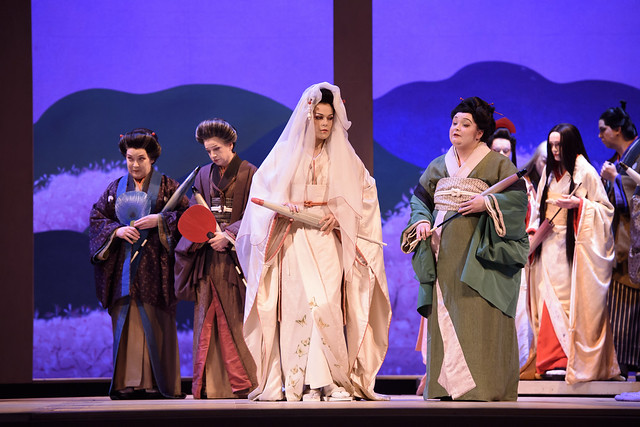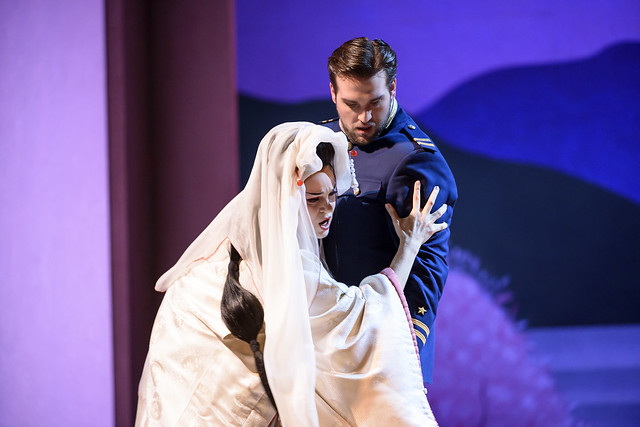By Mary Grace Nguyen
Despite already made in two operas and ballet
form, Puccini persisted in replicating his own opera, Manon Lescaut which
was also based on the 1731 novel L’histoire du chevalier des Grieux et
de Manon Lescaut by the Abbé Prévost.
It has been 30 years since Puccini’s version of Manon Lescaut has
been performed in Covent Garden but the director, Jonathan Kent has just
produced something that was all the more worthwhile. At its premiere in 1893
(in Turin) it was Puccini’s third opera, which received many great reviews yet
unfortunately for Kent's production, some members of the audience were so
disappointed that they felt the need to boo.

In its simplest form, Manon Lescaut is the
story of young girl that is sent to a convent on her father’s wishes whom Des
Grieux falls in love with it. They both escape to Paris to be together yet once
Des Grieux’s money runs dry Manon becomes distracted by Geronte's offer for a
luxurious and wealthy life that she abandons him. Only later on does she
realize - as part of her downfall - that Des Grieux is the man she loves, yet
she tragically dies as they both try to escape to America.

In Kent’s version with set designs created by Paul
Brown, it isn’t as rose tinted or straightforward, which isn’t necessarily a
bad thing. Act 1 begins with two sets on one stage; gambling casino on one side
and a semi American style holiday inn on the other; students dressed in modern
day gear including Sponge Bob are milling around. Des Grieux (Jonas Kaufmann)
dressed in a causal suit enters taking the female audiences’ breathe away with
his male dominating tenor voice; he is shortly swept away by modestly dressed
Manon (Kristīne Opolais) as he sings, Donna non vidi mai. Manon
enters by being driven in by a people carrier; yes! an actual Mercedes made a
cameo appearance at the Royal Opera House and her hypocritical brother, Lescaut,
(Christopher Maltman) has unethical, greedy plans for her sister to be sold off to Geronte (Maurizio Muraro,) a rich lascivious
businessman.
By Act 2, Opolais is no longer innocent but dressed in a tight
fit, bust improvising pink corset with white stockings and a blonde wig; in a
hot pink boudoir, she prances around flirting and teasing not only Geronte, but
other old perverted men sitting in a row watching Manon like prey in some
voyeuristic and debauched surroundings. The titillation is exacerbated
by Manon straddling Geronte and Nedezhda Karyazina as a musician
slash sex worker caressing Manon in order to indulge the fantasies of their
audience. In Act 3, after Geronte catches Manon and Des Grieux together,
he manages to give her to the police which leads onto another unsettling scene:
women who appear like human traffickers are recorded on film as they queue and
walk on a conveyer belt to be shipped off whilst being shoved around by an
apathetic emcee. By Act 4, Manon’s hair is in tangles, her corset is no longer
fluffy and pristine but tattered as Des Grieux drags her up what looks like a
grey, deserted and broken fly over where she dies in his arm having sung, ‘Sola,
perduta, abbandonata.’ Not a pretty picture is it? Kent however, is adamant
that he has conveyed Puccini's opera in a way that will bring the audiences'
attention to what the composer was alluding to when he decided to re-create Manon Lescaut, which had already been
made in different guises by Jules Massenet and Daniel Auber.

Puccini once said: "Manon
is a heroine I believe in and therefore she cannot fail to win the hearts of
the public…A woman like Manon can have more than one lover." When he
compared himself to Massenet’s Manon, he said, ‘I shall feel it as an Italian,
with a desperate passion." Manon Lescaut is an intriguing character
because she is entirely human; she is frail, wreckless and easily swayed by
luxury. Only in Act 2 when she gets bored in in quelle
trine morbide and realizes how
unsustainable materialism is in securing happiness does she withdraw and long
for Des Grieux’s love. With Brown’s set designs and Manon’s flirty lap
dancing for the seedy Geronte, it appears to project - perhaps - the same
awkwardness and dissatisfaction felt by Manon to the audience in that the scene
itself is so obscene that Manon presents the ludicrous situation of finding
herself being objectified. Her capriciousness and fickleness from wanting Des
Grieux to wanting riches and then no longer wanting it is tremendously alluring
that it enhances her attractiveness to the audience - both on stage and off. Kauffmann said, ‘It’s
horrible to imagine a man falling for her [because if you do] you’re absolutely
screwed!’ This is conveyed the most when Manon unashamedly argues with Des
Grieux about finding her jewels before they leave, which leads her behind bars.
Opolais’s Manon is a beautifully spoilt
violet that lucidly shows her digression and physically exhausting journey
towards her impending death. Her voice was just right for Kauffmann who she
said helped and made her ‘want to sing better’; their voices put together were
incredible. Kauffmann seems to sound better each time I see him; his voice is
something to admire and for this performance alone, I believe he has earned his
stripes; someone should give him the role of Calaf which he so deserves.
Maltman who also plays a sergeant of the
royal guards in Act 3 portrayed two very different characters in great clarity;
the first as a laissez faire realist and another as a sympathetic fella; his
voice didn’t fail him either. Muraro as a filthy rich and lecherous fiend
succeeded in making an audience find him distasteful which is quite the polar
opposite of his latest role as a harmless and cheerful philosopher, Don Alfonso
at the Metropolitan Opera’s performance of Cosi Fan Tutti. And Benjamin Hulett, as Edmondo proved that even tenors with scruffy hair in green anoraks
that dance around street poles can sing very well.
Antonio Papanno, the conductor, showed his sheer
passion for Puccini’s work by extrapolated the musical score and tying it in
neatly with the singers (Kauffman and Opolais) way of singing and the lyrics.
In the behind-the-scenes footage (provided by the Royal Opera House), Opolais
explains how it's in the ‘small
phrases’ that have a massive influence on the opera itself. Pappano said of Puccini’s work that, ‘[it] is often done
with great splashes of passion… but it’s more than that. It has to be balanced
by refinement; the passion has to be true, the tragedy has to be true'. The
orchestra played immensely and beautifully; one could tell that Papanno wanted
to pay homage to Puccini by conducted Manon Lescaut with inspiration.
There are moments in the Manon Lescaut where you
can hear glimpses of songs that would influence Puccini’s later operas
particularly in the Intermezzo in Act 2; one can hear similar melodies that
induce the same emotions in La Boheme, Tosca and Madam Butterfly.
Conclusion
Brown's stage design and Kent's overall production
irritated some opera-goers but, why is that? Perhaps they expected 18th
century period costume or something a bit more mythical and easy on the eyes.
Yet what is wrong with realism? What’s wrong with seeing opera in a
contemporary setting that may provoke? I have read a few reviews that have said
that the music did not coincide with the production set but I disagree. No
matter how bleak a stage or scenario, no matter how cheesy or sumptuous, it is
still human emotions, which is felt -more or less - in the same way. There was a certain warmth and depth emitted from both Opolais and Kauffmann which
Puccini’s music entitled them with. The stage setting didn’t put me off
whatsoever, in fact, the striking and controversial sets and props challenged
me; I found myself asking questions about what Kent was trying to imply here and there yet it
didn’t take me too long to realize his creative thought process which I
completely understand. My only quibble however, is that some of the audience
members couldn't see the last act, which was on an elevated fly over and the best scene out of the entire production, in my opinion
For more information on the production at the Royal Opera House, please click here
Last showing of this production was July 7th 2014











%20ROH.%20PHOTOGRAPHER%20BILL%20COOPER.jpg)




